The Capital University: 3G Wireless Network Video QoS Research Project
VerifiedAdded on 2021/07/07
|9
|2015
|20
Project
AI Summary
This research project, submitted to the Department of Electrical Engineering at The Capital University of Science & Technology Islamabad, evaluates the Video Quality of Service (QoS) in 3G Wireless Networks. The project begins with an introduction to the evolution of mobile wireless communication, from 1G to 3G, highlighting the advancements in data rates and capabilities. The report then presents a literature review, discussing various research papers that explore QoS parameters, cell tiering, and scheduling strategies. A gap analysis identifies issues such as the limitations of cell tiering and the challenges of efficient resource management in 3G/UMTS networks. The problem statement emphasizes the need for improved QoS to handle the increasing demand for constant applications like video and voice communication. The methodology section proposes approaches to enhance video and voice transmission quality, including the utilization of QoS managers and Adaptive Resource Management (ARM). The potential of IntServ, DiffServ, and MPLS is also discussed. The report concludes with future work, suggesting the design of a common QoS plan for heterogeneous networks. The author is Usama Ahmad, and the project was submitted in June 2021.

---------------------------------------------------------------------------------------------------------------
Evaluation of Video Quality of Service in 3G Wireless Networks
Usama Ahmad
The Capital University Of Science & Technology Islamabad
---------------------------------------------------------------------------------------
Submitted by: Usama Ahmad
Roll Number: MEE193027
Submitted to: Engr. Prof. Dr. Noor M. Khan
Submission Date: 23 June, 2021.
1
The Capital University Of Science & Technology Islamabad
Department of Electrical Engineering
Research Project Assignment–Cellular MobileCommunications
Evaluation of Video Quality of Service in 3G Wireless Networks
Usama Ahmad
The Capital University Of Science & Technology Islamabad
---------------------------------------------------------------------------------------
Submitted by: Usama Ahmad
Roll Number: MEE193027
Submitted to: Engr. Prof. Dr. Noor M. Khan
Submission Date: 23 June, 2021.
1
The Capital University Of Science & Technology Islamabad
Department of Electrical Engineering
Research Project Assignment–Cellular MobileCommunications
Paraphrase This Document
Need a fresh take? Get an instant paraphrase of this document with our AI Paraphraser
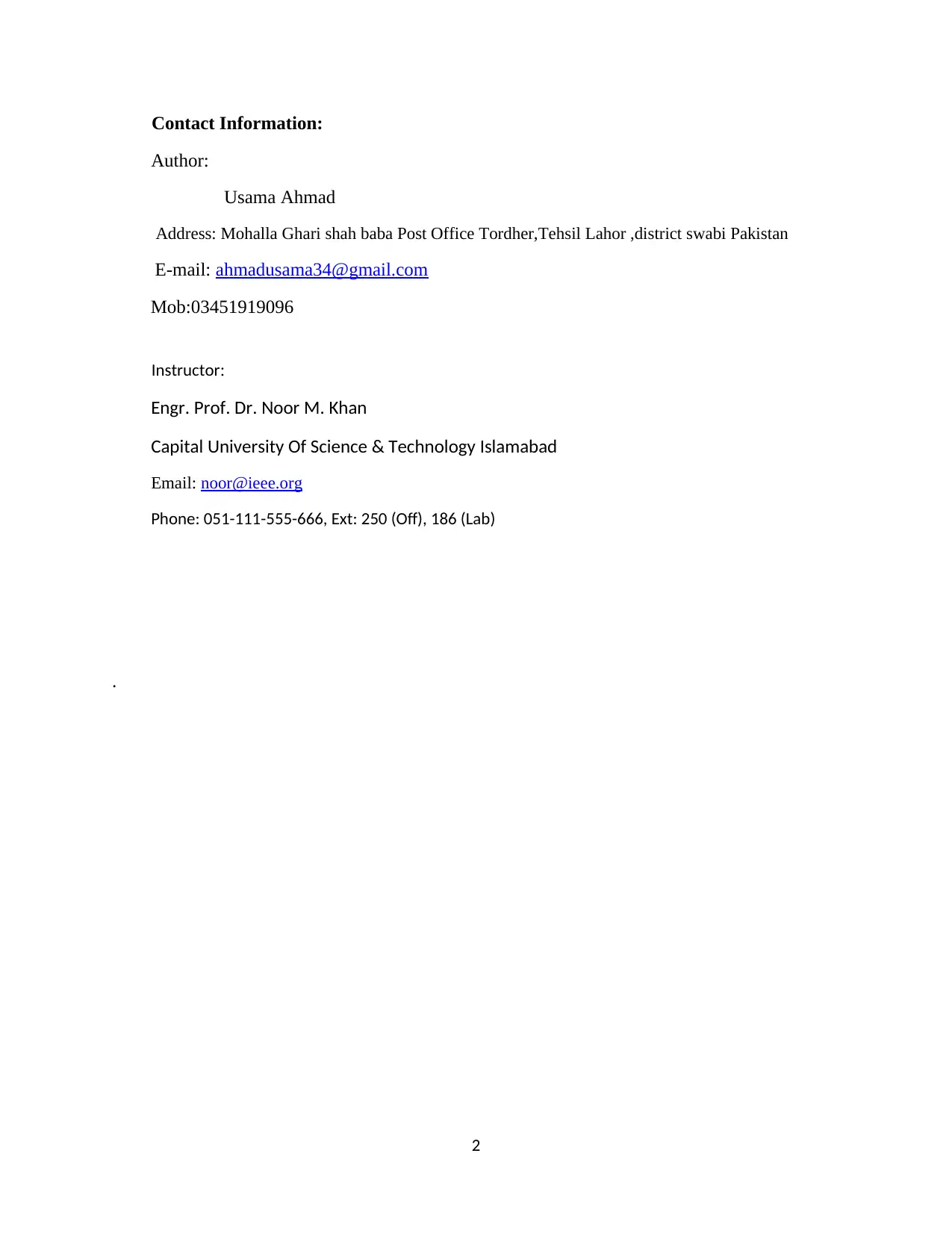
Contact Information:
Author:
Usama Ahmad
Address: Mohalla Ghari shah baba Post Office Tordher,Tehsil Lahor ,district swabi Pakistan
E-mail: ahmadusama34@gmail.com
Mob:03451919096
Instructor:
Engr. Prof. Dr. Noor M. Khan
Capital University Of Science & Technology Islamabad
Email: noor@ieee.org
Phone: 051-111-555-666, Ext: 250 (Off), 186 (Lab)
.
2
Author:
Usama Ahmad
Address: Mohalla Ghari shah baba Post Office Tordher,Tehsil Lahor ,district swabi Pakistan
E-mail: ahmadusama34@gmail.com
Mob:03451919096
Instructor:
Engr. Prof. Dr. Noor M. Khan
Capital University Of Science & Technology Islamabad
Email: noor@ieee.org
Phone: 051-111-555-666, Ext: 250 (Off), 186 (Lab)
.
2
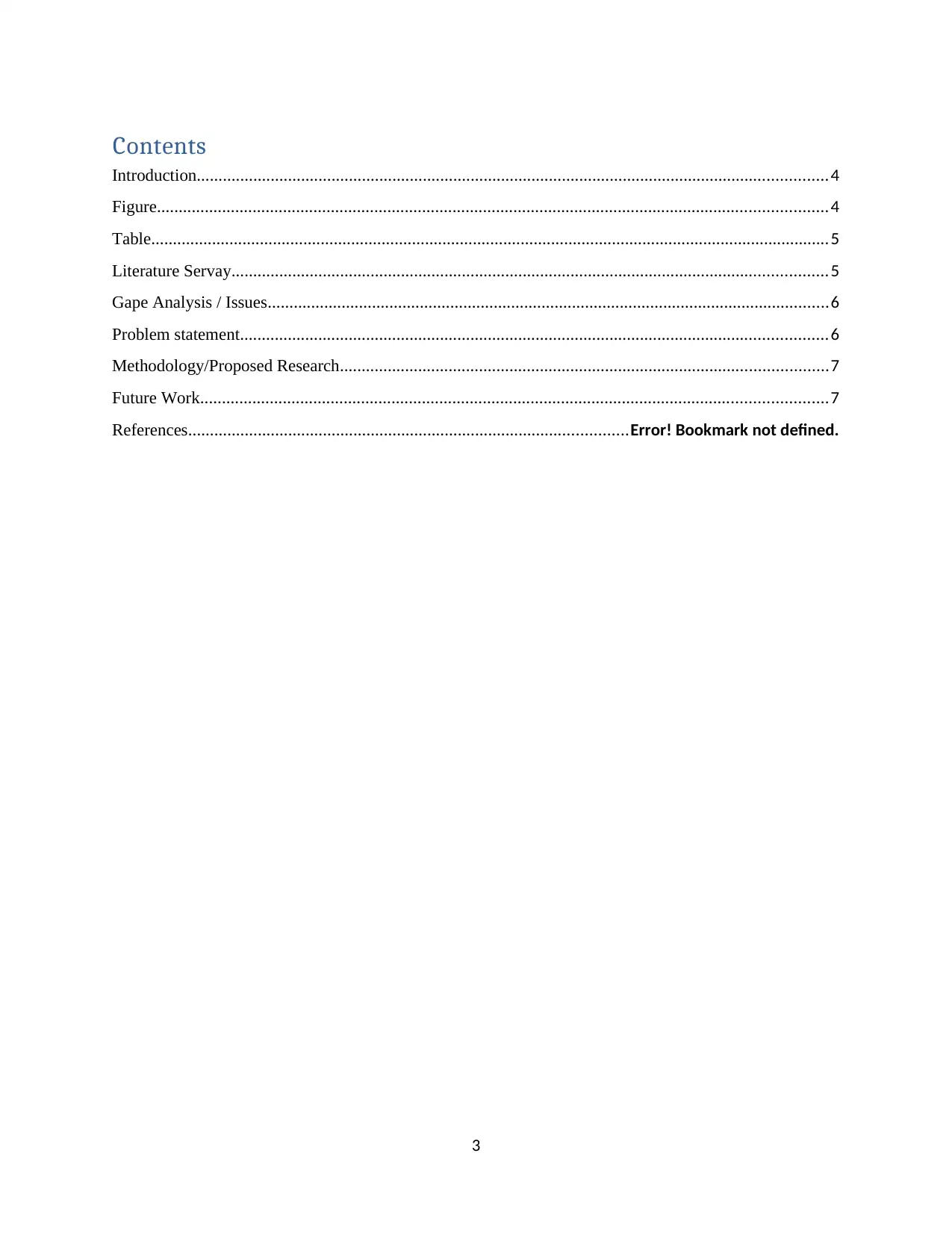
Contents
Introduction.................................................................................................................................................4
Figure..........................................................................................................................................................4
Table............................................................................................................................................................5
Literature Servay.........................................................................................................................................5
Gape Analysis / Issues.................................................................................................................................6
Problem statement.......................................................................................................................................6
Methodology/Proposed Research................................................................................................................7
Future Work................................................................................................................................................7
References.....................................................................................................Error! Bookmark not defined.
3
Introduction.................................................................................................................................................4
Figure..........................................................................................................................................................4
Table............................................................................................................................................................5
Literature Servay.........................................................................................................................................5
Gape Analysis / Issues.................................................................................................................................6
Problem statement.......................................................................................................................................6
Methodology/Proposed Research................................................................................................................7
Future Work................................................................................................................................................7
References.....................................................................................................Error! Bookmark not defined.
3
⊘ This is a preview!⊘
Do you want full access?
Subscribe today to unlock all pages.

Trusted by 1+ million students worldwide
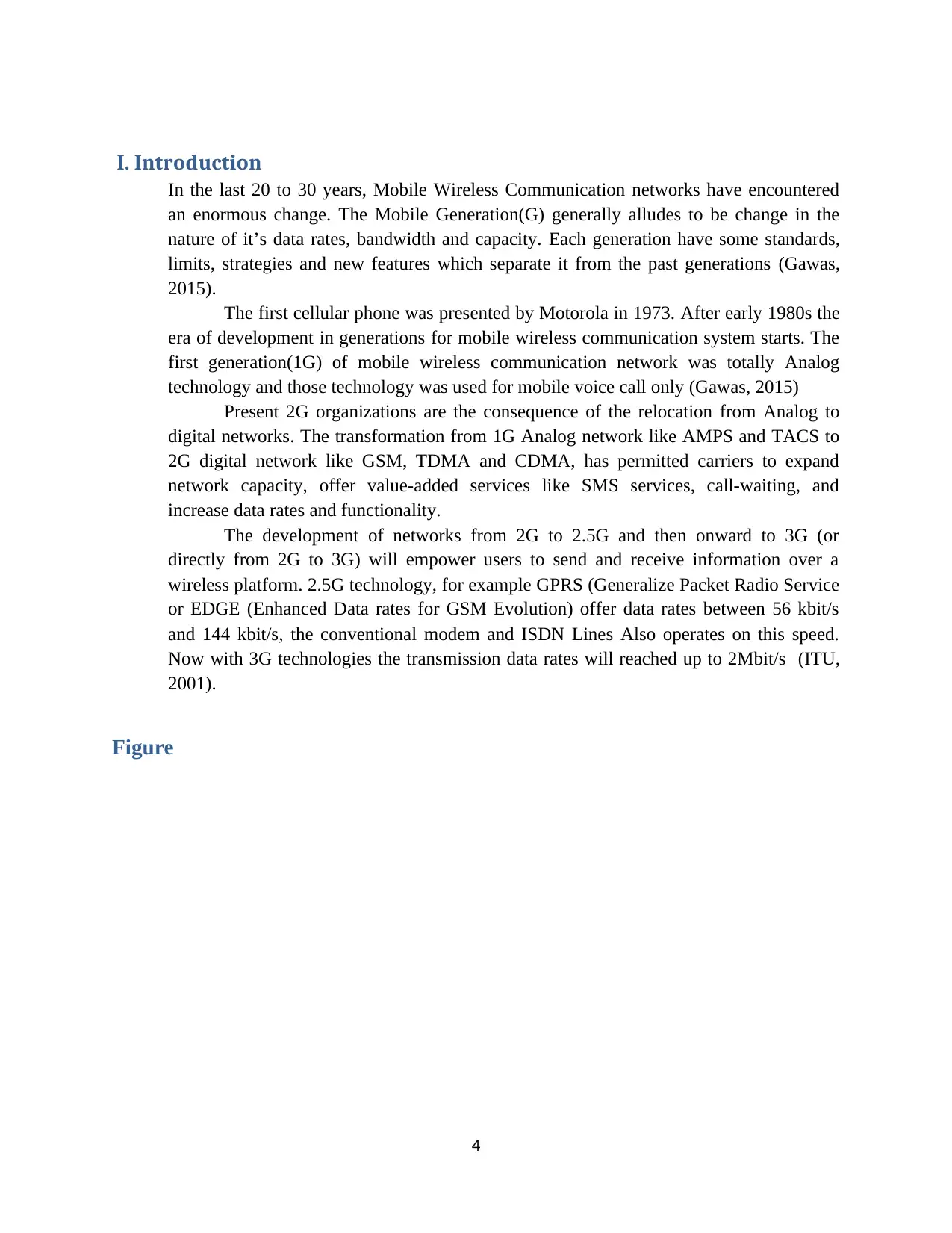
I. Introduction
In the last 20 to 30 years, Mobile Wireless Communication networks have encountered
an enormous change. The Mobile Generation(G) generally alludes to be change in the
nature of it’s data rates, bandwidth and capacity. Each generation have some standards,
limits, strategies and new features which separate it from the past generations (Gawas,
2015).
The first cellular phone was presented by Motorola in 1973. After early 1980s the
era of development in generations for mobile wireless communication system starts. The
first generation(1G) of mobile wireless communication network was totally Analog
technology and those technology was used for mobile voice call only (Gawas, 2015)
Present 2G organizations are the consequence of the relocation from Analog to
digital networks. The transformation from 1G Analog network like AMPS and TACS to
2G digital network like GSM, TDMA and CDMA, has permitted carriers to expand
network capacity, offer value-added services like SMS services, call-waiting, and
increase data rates and functionality.
The development of networks from 2G to 2.5G and then onward to 3G (or
directly from 2G to 3G) will empower users to send and receive information over a
wireless platform. 2.5G technology, for example GPRS (Generalize Packet Radio Service
or EDGE (Enhanced Data rates for GSM Evolution) offer data rates between 56 kbit/s
and 144 kbit/s, the conventional modem and ISDN Lines Also operates on this speed.
Now with 3G technologies the transmission data rates will reached up to 2Mbit/s (ITU,
2001).
Figure
4
In the last 20 to 30 years, Mobile Wireless Communication networks have encountered
an enormous change. The Mobile Generation(G) generally alludes to be change in the
nature of it’s data rates, bandwidth and capacity. Each generation have some standards,
limits, strategies and new features which separate it from the past generations (Gawas,
2015).
The first cellular phone was presented by Motorola in 1973. After early 1980s the
era of development in generations for mobile wireless communication system starts. The
first generation(1G) of mobile wireless communication network was totally Analog
technology and those technology was used for mobile voice call only (Gawas, 2015)
Present 2G organizations are the consequence of the relocation from Analog to
digital networks. The transformation from 1G Analog network like AMPS and TACS to
2G digital network like GSM, TDMA and CDMA, has permitted carriers to expand
network capacity, offer value-added services like SMS services, call-waiting, and
increase data rates and functionality.
The development of networks from 2G to 2.5G and then onward to 3G (or
directly from 2G to 3G) will empower users to send and receive information over a
wireless platform. 2.5G technology, for example GPRS (Generalize Packet Radio Service
or EDGE (Enhanced Data rates for GSM Evolution) offer data rates between 56 kbit/s
and 144 kbit/s, the conventional modem and ISDN Lines Also operates on this speed.
Now with 3G technologies the transmission data rates will reached up to 2Mbit/s (ITU,
2001).
Figure
4
Paraphrase This Document
Need a fresh take? Get an instant paraphrase of this document with our AI Paraphraser
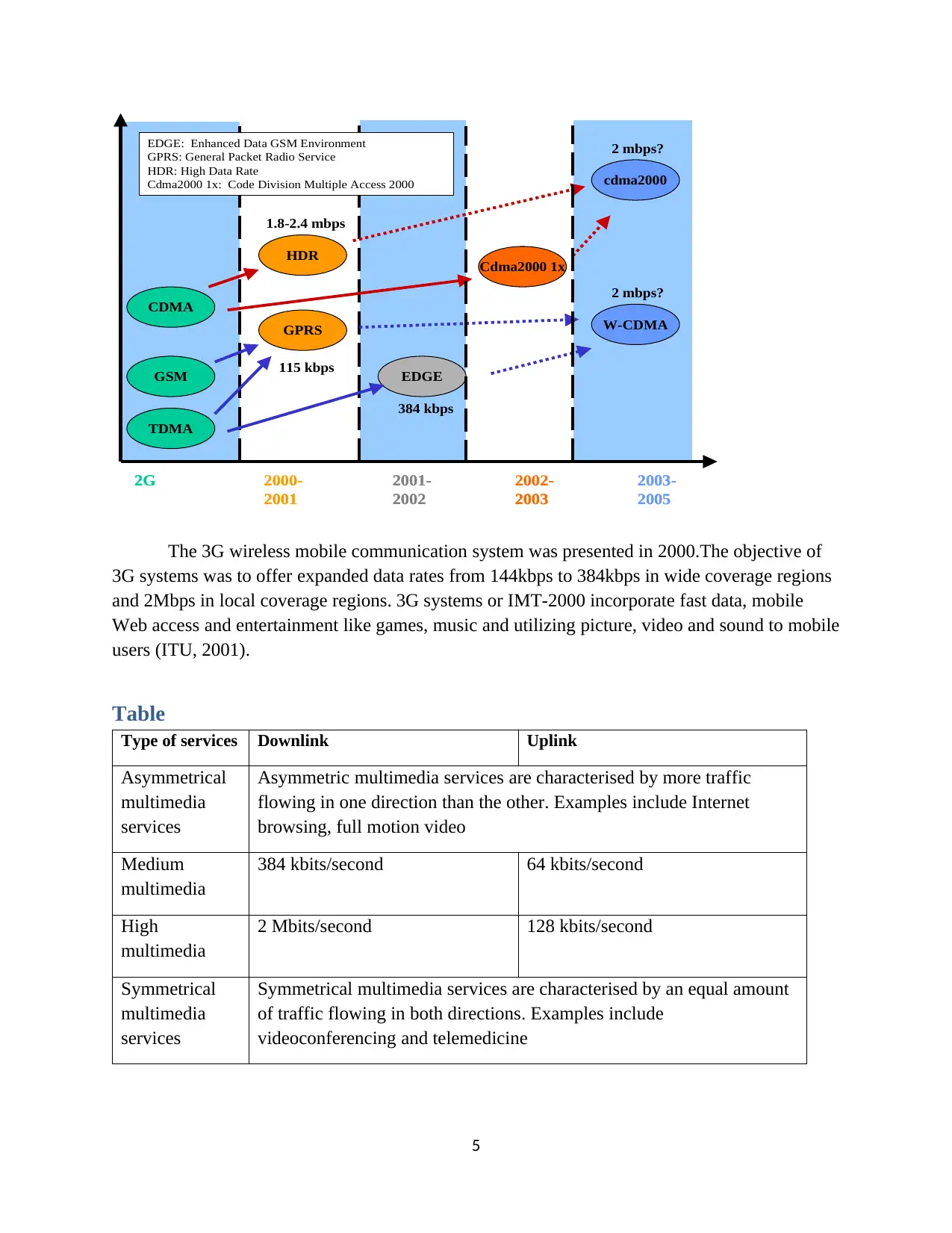
CDMA
GSM
TDMA
HDR
GPRS
EDGE
Cdma2000 1x
cdma2000
W-CDMA
2G 2001-
2002
2000-
2001
2002-
2003
2003-
2005
384 kbps
1.8-2.4 mbps
115 kbps
2 mbps?
2 mbps?
EDGE: Enhanced Data GSM Environment
GPRS: General Packet Radio Service
HDR: High Data Rate
Cdma2000 1x: Code Division Multiple Access 2000
CDMA
GSM
TDMA
HDR
GPRS
EDGE
Cdma2000 1x
cdma2000
W-CDMA
2G 2001-
2002
2000-
2001
2002-
2003
2003-
2005
384 kbps
1.8-2.4 mbps
115 kbps
2 mbps?
2 mbps?
EDGE: Enhanced Data GSM Environment
GPRS: General Packet Radio Service
HDR: High Data Rate
Cdma2000 1x: Code Division Multiple Access 2000
The 3G wireless mobile communication system was presented in 2000.The objective of
3G systems was to offer expanded data rates from 144kbps to 384kbps in wide coverage regions
and 2Mbps in local coverage regions. 3G systems or IMT-2000 incorporate fast data, mobile
Web access and entertainment like games, music and utilizing picture, video and sound to mobile
users (ITU, 2001).
Table
Type of services Downlink Uplink
Asymmetrical
multimedia
services
Asymmetric multimedia services are characterised by more traffic
flowing in one direction than the other. Examples include Internet
browsing, full motion video
Medium
multimedia
384 kbits/second 64 kbits/second
High
multimedia
2 Mbits/second 128 kbits/second
Symmetrical
multimedia
services
Symmetrical multimedia services are characterised by an equal amount
of traffic flowing in both directions. Examples include
videoconferencing and telemedicine
5
GSM
TDMA
HDR
GPRS
EDGE
Cdma2000 1x
cdma2000
W-CDMA
2G 2001-
2002
2000-
2001
2002-
2003
2003-
2005
384 kbps
1.8-2.4 mbps
115 kbps
2 mbps?
2 mbps?
EDGE: Enhanced Data GSM Environment
GPRS: General Packet Radio Service
HDR: High Data Rate
Cdma2000 1x: Code Division Multiple Access 2000
CDMA
GSM
TDMA
HDR
GPRS
EDGE
Cdma2000 1x
cdma2000
W-CDMA
2G 2001-
2002
2000-
2001
2002-
2003
2003-
2005
384 kbps
1.8-2.4 mbps
115 kbps
2 mbps?
2 mbps?
EDGE: Enhanced Data GSM Environment
GPRS: General Packet Radio Service
HDR: High Data Rate
Cdma2000 1x: Code Division Multiple Access 2000
The 3G wireless mobile communication system was presented in 2000.The objective of
3G systems was to offer expanded data rates from 144kbps to 384kbps in wide coverage regions
and 2Mbps in local coverage regions. 3G systems or IMT-2000 incorporate fast data, mobile
Web access and entertainment like games, music and utilizing picture, video and sound to mobile
users (ITU, 2001).
Table
Type of services Downlink Uplink
Asymmetrical
multimedia
services
Asymmetric multimedia services are characterised by more traffic
flowing in one direction than the other. Examples include Internet
browsing, full motion video
Medium
multimedia
384 kbits/second 64 kbits/second
High
multimedia
2 Mbits/second 128 kbits/second
Symmetrical
multimedia
services
Symmetrical multimedia services are characterised by an equal amount
of traffic flowing in both directions. Examples include
videoconferencing and telemedicine
5
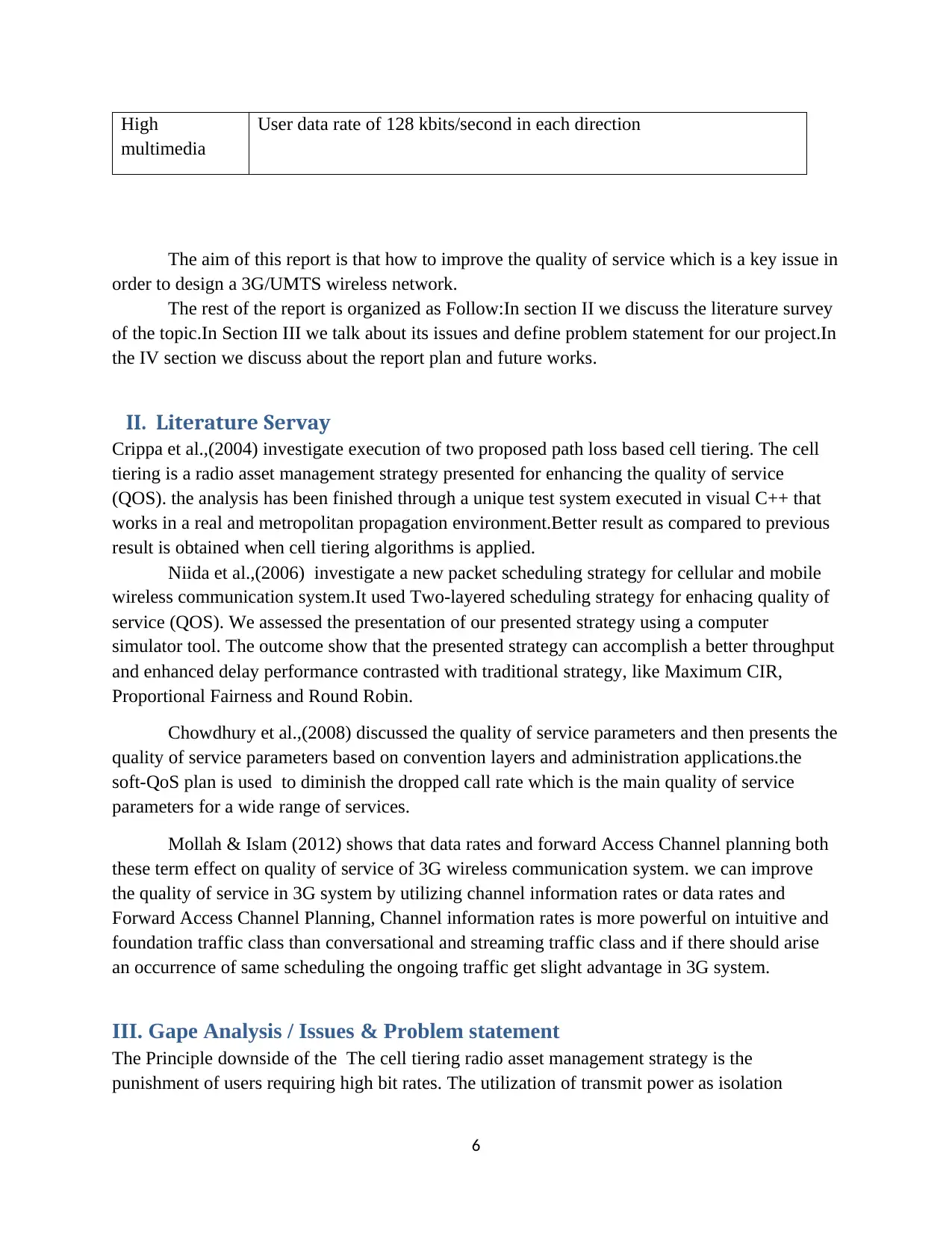
High
multimedia
User data rate of 128 kbits/second in each direction
The aim of this report is that how to improve the quality of service which is a key issue in
order to design a 3G/UMTS wireless network.
The rest of the report is organized as Follow:In section II we discuss the literature survey
of the topic.In Section III we talk about its issues and define problem statement for our project.In
the IV section we discuss about the report plan and future works.
II. Literature Servay
Crippa et al.,(2004) investigate execution of two proposed path loss based cell tiering. The cell
tiering is a radio asset management strategy presented for enhancing the quality of service
(QOS). the analysis has been finished through a unique test system executed in visual C++ that
works in a real and metropolitan propagation environment.Better result as compared to previous
result is obtained when cell tiering algorithms is applied.
Niida et al.,(2006) investigate a new packet scheduling strategy for cellular and mobile
wireless communication system.It used Two-layered scheduling strategy for enhacing quality of
service (QOS). We assessed the presentation of our presented strategy using a computer
simulator tool. The outcome show that the presented strategy can accomplish a better throughput
and enhanced delay performance contrasted with traditional strategy, like Maximum CIR,
Proportional Fairness and Round Robin.
Chowdhury et al.,(2008) discussed the quality of service parameters and then presents the
quality of service parameters based on convention layers and administration applications.the
soft-QoS plan is used to diminish the dropped call rate which is the main quality of service
parameters for a wide range of services.
Mollah & Islam (2012) shows that data rates and forward Access Channel planning both
these term effect on quality of service of 3G wireless communication system. we can improve
the quality of service in 3G system by utilizing channel information rates or data rates and
Forward Access Channel Planning, Channel information rates is more powerful on intuitive and
foundation traffic class than conversational and streaming traffic class and if there should arise
an occurrence of same scheduling the ongoing traffic get slight advantage in 3G system.
III. Gape Analysis / Issues & Problem statement
The Principle downside of the The cell tiering radio asset management strategy is the
punishment of users requiring high bit rates. The utilization of transmit power as isolation
6
multimedia
User data rate of 128 kbits/second in each direction
The aim of this report is that how to improve the quality of service which is a key issue in
order to design a 3G/UMTS wireless network.
The rest of the report is organized as Follow:In section II we discuss the literature survey
of the topic.In Section III we talk about its issues and define problem statement for our project.In
the IV section we discuss about the report plan and future works.
II. Literature Servay
Crippa et al.,(2004) investigate execution of two proposed path loss based cell tiering. The cell
tiering is a radio asset management strategy presented for enhancing the quality of service
(QOS). the analysis has been finished through a unique test system executed in visual C++ that
works in a real and metropolitan propagation environment.Better result as compared to previous
result is obtained when cell tiering algorithms is applied.
Niida et al.,(2006) investigate a new packet scheduling strategy for cellular and mobile
wireless communication system.It used Two-layered scheduling strategy for enhacing quality of
service (QOS). We assessed the presentation of our presented strategy using a computer
simulator tool. The outcome show that the presented strategy can accomplish a better throughput
and enhanced delay performance contrasted with traditional strategy, like Maximum CIR,
Proportional Fairness and Round Robin.
Chowdhury et al.,(2008) discussed the quality of service parameters and then presents the
quality of service parameters based on convention layers and administration applications.the
soft-QoS plan is used to diminish the dropped call rate which is the main quality of service
parameters for a wide range of services.
Mollah & Islam (2012) shows that data rates and forward Access Channel planning both
these term effect on quality of service of 3G wireless communication system. we can improve
the quality of service in 3G system by utilizing channel information rates or data rates and
Forward Access Channel Planning, Channel information rates is more powerful on intuitive and
foundation traffic class than conversational and streaming traffic class and if there should arise
an occurrence of same scheduling the ongoing traffic get slight advantage in 3G system.
III. Gape Analysis / Issues & Problem statement
The Principle downside of the The cell tiering radio asset management strategy is the
punishment of users requiring high bit rates. The utilization of transmit power as isolation
6
⊘ This is a preview!⊘
Do you want full access?
Subscribe today to unlock all pages.

Trusted by 1+ million students worldwide
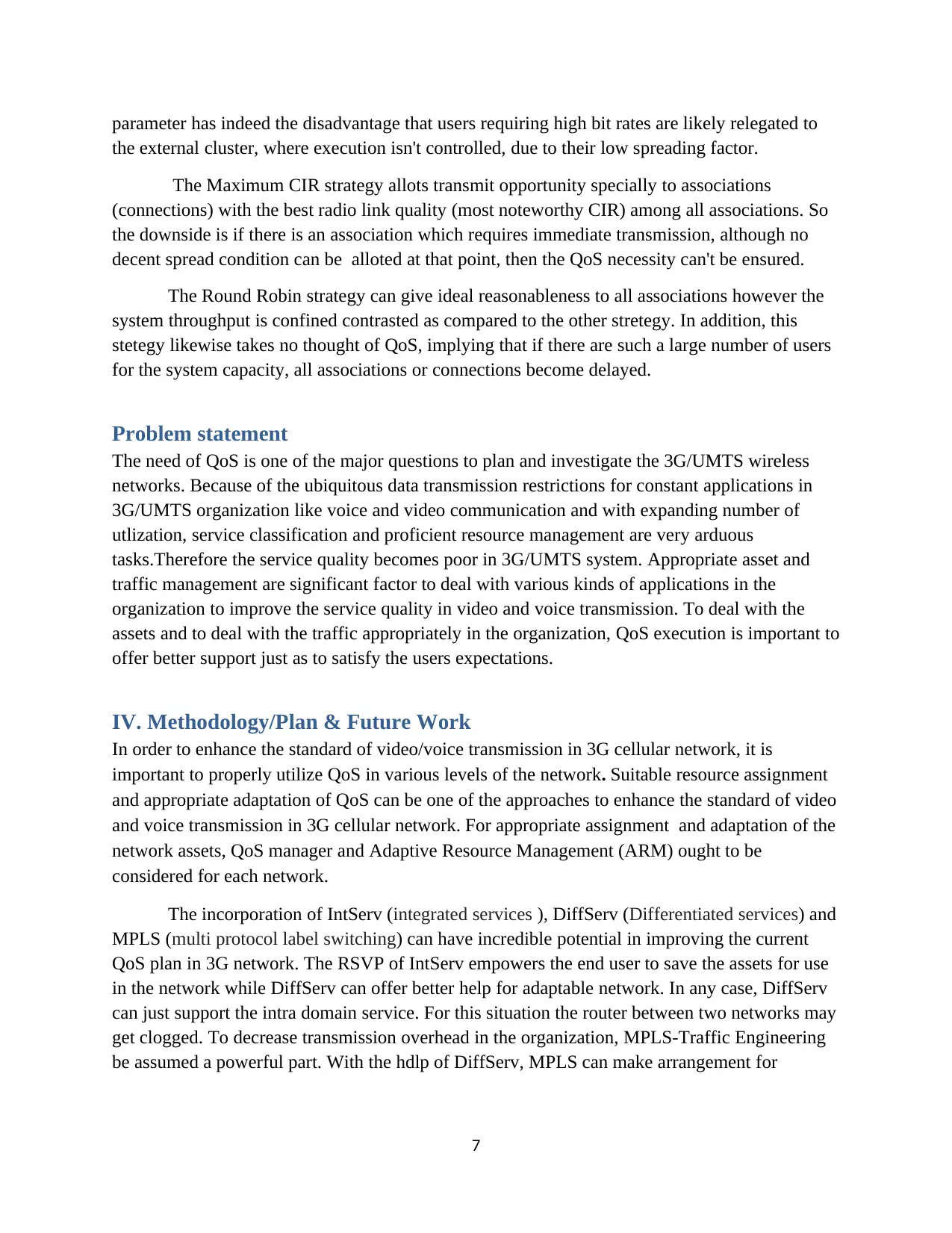
parameter has indeed the disadvantage that users requiring high bit rates are likely relegated to
the external cluster, where execution isn't controlled, due to their low spreading factor.
The Maximum CIR strategy allots transmit opportunity specially to associations
(connections) with the best radio link quality (most noteworthy CIR) among all associations. So
the downside is if there is an association which requires immediate transmission, although no
decent spread condition can be alloted at that point, then the QoS necessity can't be ensured.
The Round Robin strategy can give ideal reasonableness to all associations however the
system throughput is confined contrasted as compared to the other stretegy. In addition, this
stetegy likewise takes no thought of QoS, implying that if there are such a large number of users
for the system capacity, all associations or connections become delayed.
Problem statement
The need of QoS is one of the major questions to plan and investigate the 3G/UMTS wireless
networks. Because of the ubiquitous data transmission restrictions for constant applications in
3G/UMTS organization like voice and video communication and with expanding number of
utlization, service classification and proficient resource management are very arduous
tasks.Therefore the service quality becomes poor in 3G/UMTS system. Appropriate asset and
traffic management are significant factor to deal with various kinds of applications in the
organization to improve the service quality in video and voice transmission. To deal with the
assets and to deal with the traffic appropriately in the organization, QoS execution is important to
offer better support just as to satisfy the users expectations.
IV. Methodology/Plan & Future Work
In order to enhance the standard of video/voice transmission in 3G cellular network, it is
important to properly utilize QoS in various levels of the network. Suitable resource assignment
and appropriate adaptation of QoS can be one of the approaches to enhance the standard of video
and voice transmission in 3G cellular network. For appropriate assignment and adaptation of the
network assets, QoS manager and Adaptive Resource Management (ARM) ought to be
considered for each network.
The incorporation of IntServ (integrated services ), DiffServ (Differentiated services) and
MPLS (multi protocol label switching) can have incredible potential in improving the current
QoS plan in 3G network. The RSVP of IntServ empowers the end user to save the assets for use
in the network while DiffServ can offer better help for adaptable network. In any case, DiffServ
can just support the intra domain service. For this situation the router between two networks may
get clogged. To decrease transmission overhead in the organization, MPLS-Traffic Engineering
be assumed a powerful part. With the hdlp of DiffServ, MPLS can make arrangement for
7
the external cluster, where execution isn't controlled, due to their low spreading factor.
The Maximum CIR strategy allots transmit opportunity specially to associations
(connections) with the best radio link quality (most noteworthy CIR) among all associations. So
the downside is if there is an association which requires immediate transmission, although no
decent spread condition can be alloted at that point, then the QoS necessity can't be ensured.
The Round Robin strategy can give ideal reasonableness to all associations however the
system throughput is confined contrasted as compared to the other stretegy. In addition, this
stetegy likewise takes no thought of QoS, implying that if there are such a large number of users
for the system capacity, all associations or connections become delayed.
Problem statement
The need of QoS is one of the major questions to plan and investigate the 3G/UMTS wireless
networks. Because of the ubiquitous data transmission restrictions for constant applications in
3G/UMTS organization like voice and video communication and with expanding number of
utlization, service classification and proficient resource management are very arduous
tasks.Therefore the service quality becomes poor in 3G/UMTS system. Appropriate asset and
traffic management are significant factor to deal with various kinds of applications in the
organization to improve the service quality in video and voice transmission. To deal with the
assets and to deal with the traffic appropriately in the organization, QoS execution is important to
offer better support just as to satisfy the users expectations.
IV. Methodology/Plan & Future Work
In order to enhance the standard of video/voice transmission in 3G cellular network, it is
important to properly utilize QoS in various levels of the network. Suitable resource assignment
and appropriate adaptation of QoS can be one of the approaches to enhance the standard of video
and voice transmission in 3G cellular network. For appropriate assignment and adaptation of the
network assets, QoS manager and Adaptive Resource Management (ARM) ought to be
considered for each network.
The incorporation of IntServ (integrated services ), DiffServ (Differentiated services) and
MPLS (multi protocol label switching) can have incredible potential in improving the current
QoS plan in 3G network. The RSVP of IntServ empowers the end user to save the assets for use
in the network while DiffServ can offer better help for adaptable network. In any case, DiffServ
can just support the intra domain service. For this situation the router between two networks may
get clogged. To decrease transmission overhead in the organization, MPLS-Traffic Engineering
be assumed a powerful part. With the hdlp of DiffServ, MPLS can make arrangement for
7
Paraphrase This Document
Need a fresh take? Get an instant paraphrase of this document with our AI Paraphraser
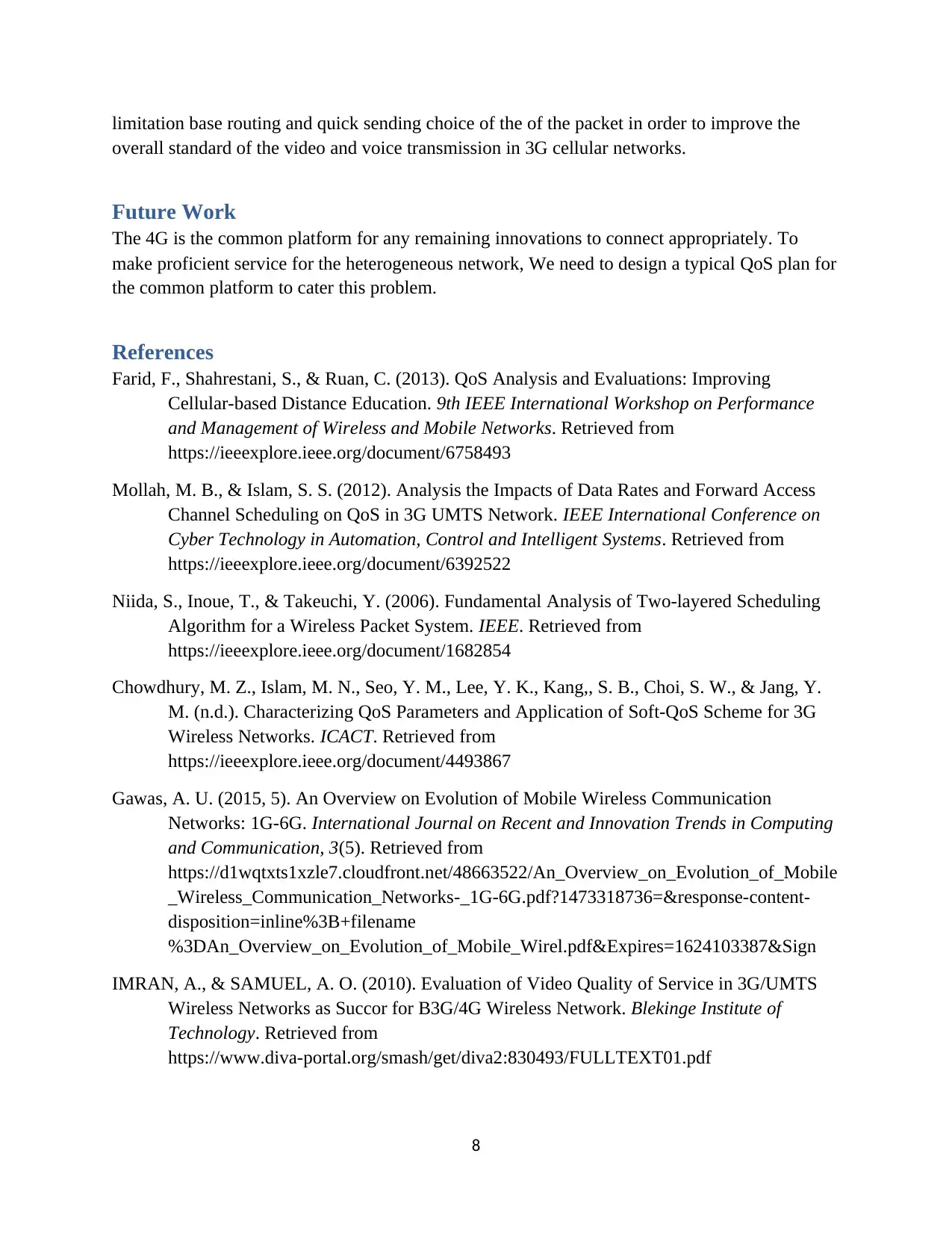
limitation base routing and quick sending choice of the of the packet in order to improve the
overall standard of the video and voice transmission in 3G cellular networks.
Future Work
The 4G is the common platform for any remaining innovations to connect appropriately. To
make proficient service for the heterogeneous network, We need to design a typical QoS plan for
the common platform to cater this problem.
References
Farid, F., Shahrestani, S., & Ruan, C. (2013). QoS Analysis and Evaluations: Improving
Cellular-based Distance Education. 9th IEEE International Workshop on Performance
and Management of Wireless and Mobile Networks. Retrieved from
https://ieeexplore.ieee.org/document/6758493
Mollah, M. B., & Islam, S. S. (2012). Analysis the Impacts of Data Rates and Forward Access
Channel Scheduling on QoS in 3G UMTS Network. IEEE International Conference on
Cyber Technology in Automation, Control and Intelligent Systems. Retrieved from
https://ieeexplore.ieee.org/document/6392522
Niida, S., Inoue, T., & Takeuchi, Y. (2006). Fundamental Analysis of Two-layered Scheduling
Algorithm for a Wireless Packet System. IEEE. Retrieved from
https://ieeexplore.ieee.org/document/1682854
Chowdhury, M. Z., Islam, M. N., Seo, Y. M., Lee, Y. K., Kang,, S. B., Choi, S. W., & Jang, Y.
M. (n.d.). Characterizing QoS Parameters and Application of Soft-QoS Scheme for 3G
Wireless Networks. ICACT. Retrieved from
https://ieeexplore.ieee.org/document/4493867
Gawas, A. U. (2015, 5). An Overview on Evolution of Mobile Wireless Communication
Networks: 1G-6G. International Journal on Recent and Innovation Trends in Computing
and Communication, 3(5). Retrieved from
https://d1wqtxts1xzle7.cloudfront.net/48663522/An_Overview_on_Evolution_of_Mobile
_Wireless_Communication_Networks-_1G-6G.pdf?1473318736=&response-content-
disposition=inline%3B+filename
%3DAn_Overview_on_Evolution_of_Mobile_Wirel.pdf&Expires=1624103387&Sign
IMRAN, A., & SAMUEL, A. O. (2010). Evaluation of Video Quality of Service in 3G/UMTS
Wireless Networks as Succor for B3G/4G Wireless Network. Blekinge Institute of
Technology. Retrieved from
https://www.diva-portal.org/smash/get/diva2:830493/FULLTEXT01.pdf
8
overall standard of the video and voice transmission in 3G cellular networks.
Future Work
The 4G is the common platform for any remaining innovations to connect appropriately. To
make proficient service for the heterogeneous network, We need to design a typical QoS plan for
the common platform to cater this problem.
References
Farid, F., Shahrestani, S., & Ruan, C. (2013). QoS Analysis and Evaluations: Improving
Cellular-based Distance Education. 9th IEEE International Workshop on Performance
and Management of Wireless and Mobile Networks. Retrieved from
https://ieeexplore.ieee.org/document/6758493
Mollah, M. B., & Islam, S. S. (2012). Analysis the Impacts of Data Rates and Forward Access
Channel Scheduling on QoS in 3G UMTS Network. IEEE International Conference on
Cyber Technology in Automation, Control and Intelligent Systems. Retrieved from
https://ieeexplore.ieee.org/document/6392522
Niida, S., Inoue, T., & Takeuchi, Y. (2006). Fundamental Analysis of Two-layered Scheduling
Algorithm for a Wireless Packet System. IEEE. Retrieved from
https://ieeexplore.ieee.org/document/1682854
Chowdhury, M. Z., Islam, M. N., Seo, Y. M., Lee, Y. K., Kang,, S. B., Choi, S. W., & Jang, Y.
M. (n.d.). Characterizing QoS Parameters and Application of Soft-QoS Scheme for 3G
Wireless Networks. ICACT. Retrieved from
https://ieeexplore.ieee.org/document/4493867
Gawas, A. U. (2015, 5). An Overview on Evolution of Mobile Wireless Communication
Networks: 1G-6G. International Journal on Recent and Innovation Trends in Computing
and Communication, 3(5). Retrieved from
https://d1wqtxts1xzle7.cloudfront.net/48663522/An_Overview_on_Evolution_of_Mobile
_Wireless_Communication_Networks-_1G-6G.pdf?1473318736=&response-content-
disposition=inline%3B+filename
%3DAn_Overview_on_Evolution_of_Mobile_Wirel.pdf&Expires=1624103387&Sign
IMRAN, A., & SAMUEL, A. O. (2010). Evaluation of Video Quality of Service in 3G/UMTS
Wireless Networks as Succor for B3G/4G Wireless Network. Blekinge Institute of
Technology. Retrieved from
https://www.diva-portal.org/smash/get/diva2:830493/FULLTEXT01.pdf
8
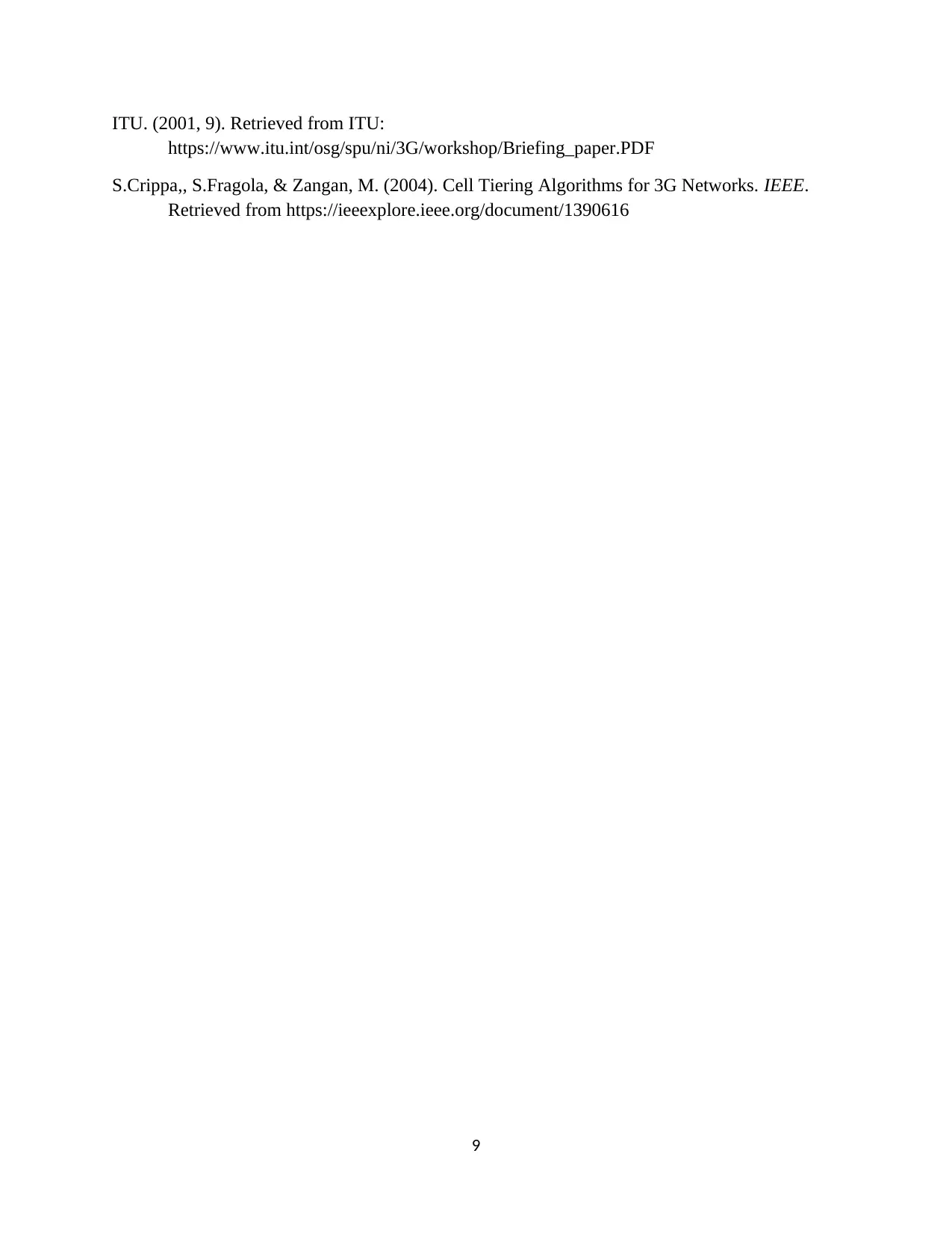
ITU. (2001, 9). Retrieved from ITU:
https://www.itu.int/osg/spu/ni/3G/workshop/Briefing_paper.PDF
S.Crippa,, S.Fragola, & Zangan, M. (2004). Cell Tiering Algorithms for 3G Networks. IEEE.
Retrieved from https://ieeexplore.ieee.org/document/1390616
9
https://www.itu.int/osg/spu/ni/3G/workshop/Briefing_paper.PDF
S.Crippa,, S.Fragola, & Zangan, M. (2004). Cell Tiering Algorithms for 3G Networks. IEEE.
Retrieved from https://ieeexplore.ieee.org/document/1390616
9
⊘ This is a preview!⊘
Do you want full access?
Subscribe today to unlock all pages.

Trusted by 1+ million students worldwide
1 out of 9
Related Documents
Your All-in-One AI-Powered Toolkit for Academic Success.
+13062052269
info@desklib.com
Available 24*7 on WhatsApp / Email
![[object Object]](/_next/static/media/star-bottom.7253800d.svg)
Unlock your academic potential
Copyright © 2020–2025 A2Z Services. All Rights Reserved. Developed and managed by ZUCOL.




